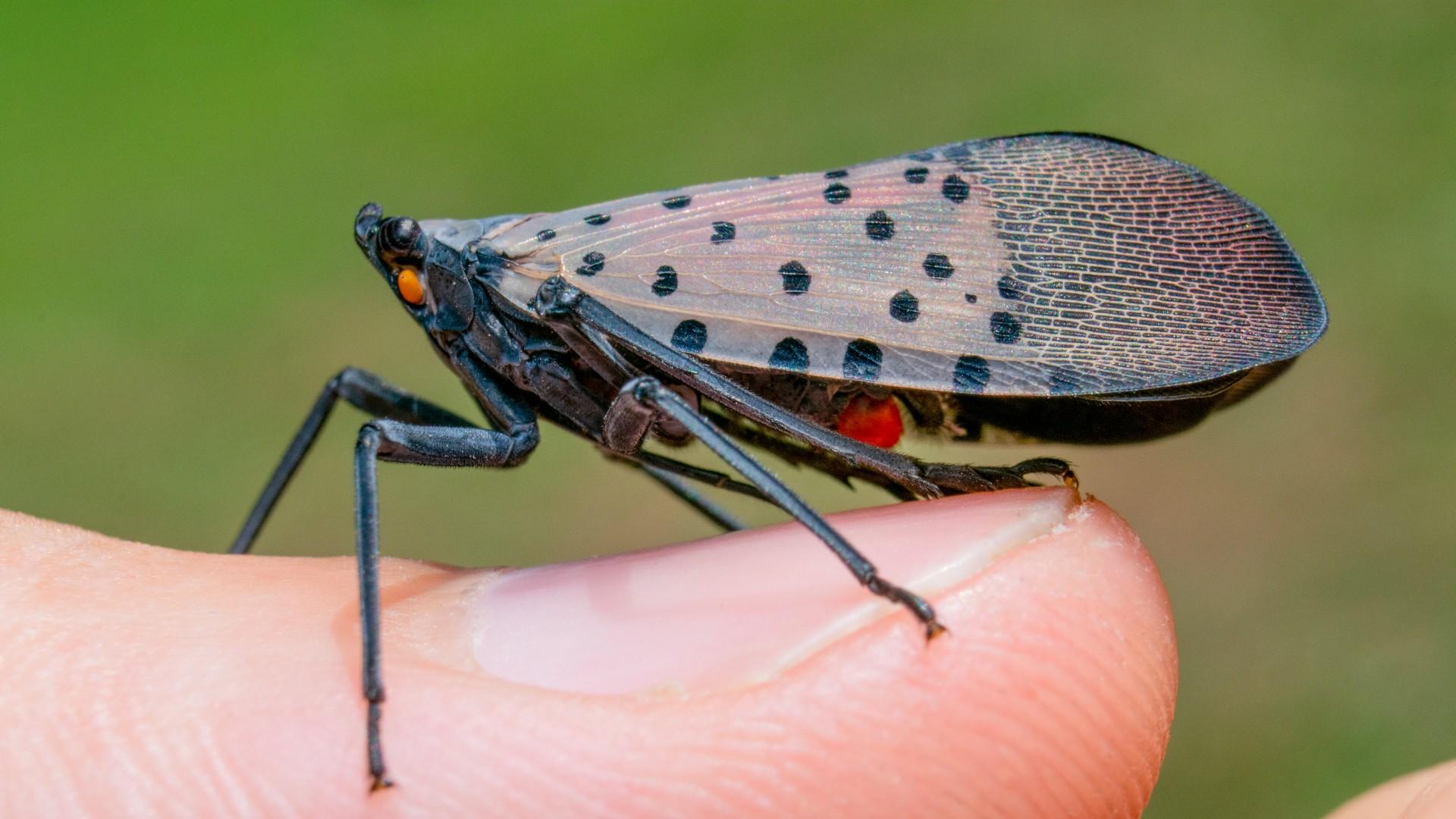Key points
-
Spotted lanternfly (Lycorma delicatula) is an invasive insect (planthopper) native to eastern Asia. It was first detected in the United States in 2014 in Berks County, Pennsylvania. In Maryland, it was first found in Cecil County in October 2018.
-
This pest does not bite or sting. Spotted lanternfly has piercing-sucking mouthparts and feeds on plant sap from a wide range of plants including grapes, hops, apples, stone fruits, maples, walnuts, and other plant species. Its feeding has not killed plants (except for grapes). It is primarily a threat to Maryland's agricultural crops.
-
All Maryland residents, from any county, are urged to report sightings of Spotted Lanternfly to the Maryland Department of Agriculture (MDA). This data is important for tracking phenology and population levels. Submit your reports through this online form. Questions or concerns about this pest also can be submitted to UMD Ask Extension, by email to DontBug.MD@maryland.gov, or call (410) 841-5920. Control information can be found at the bottom of this page.
-
Refer to (PDF) Maryland Department of Agriculture Residential Checklist if you live in an area with Spotted Lanternfly.
-
The Secretary of Agriculture has issued a quarantine order for 19 Maryland counties and Baltimore City. (View (PDF) Quarantine Map). Businesses and institutions are required to have a permit if they move regulated articles from or within the quarantined area. Further details about the quarantine zone and permit requirements can be found on the Maryland Department of Agriculture website.
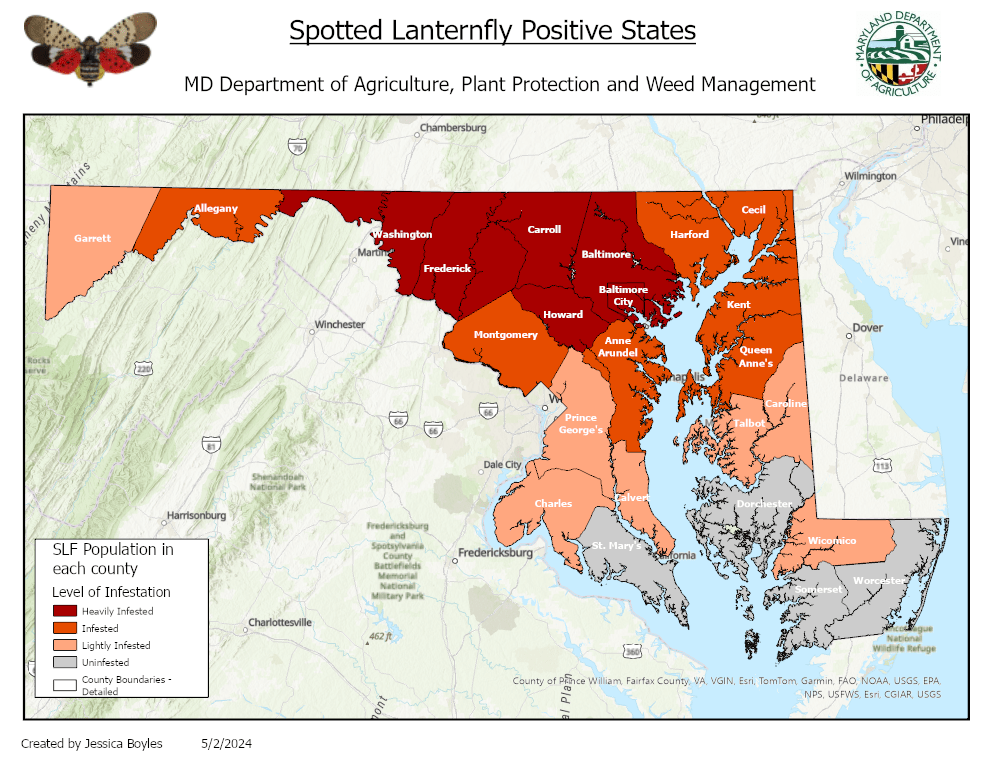
The central counties of Maryland (indicated in the darkest red) are the most heavily infested with spotted lanterflies, as of May 2024. Source: Jessica Boyles, MDA - Spotted Lanternfly Program
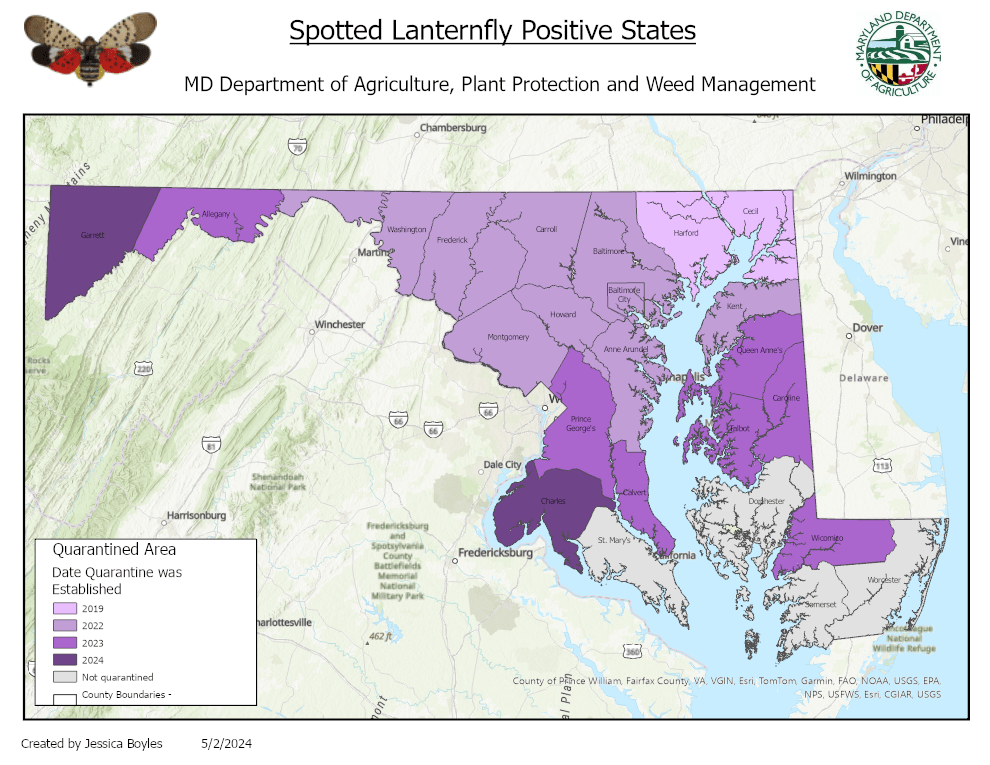
The behavior of spotted lanternfly
Spotted lanternfly is a type of planthopper insect that feeds in large groups on a wide range of plants including grapes, peaches, apples, walnuts, oaks, and pines. They do not bite or sting people or pets.
Both adults and nymphs (immatures) feed by sucking sap (phloem) from plant stems and trunks. During feeding, they produce a sugary waste substance called honeydew. Honeydew can accumulate and stick to understory plants as well as objects. This sugary substance can attract other pests and support the growth of sooty mold, which can contaminate and reduce the value of fruits, reduce plant photosynthesis, and weaken overall plant health. Please note: wasps may be attracted to the honeydew, and caution should be used if a spotted lanternfly-infested plant is in a high-traffic area. For more information on wasps, please see our social wasps page.

Red oak leaves with honeydew from spotted lanternfly feeding. Photo: Lawrence Barringer, Pennsylvania Department of Agriculture, Bugwood.org
A primary host plant for the spotted lanternfly is tree-of-heaven (Ailanthus altissima), an invasive weedy tree that grows in disturbed areas on field edges and roadsides. Early research suggests that spotted lanternfly may prefer to feed and reproduce on tree-of-heaven, but research has shown it also can complete its life cycle on a wide range of other plant species. Refer to our information about tree-of-heaven and how to remove it.
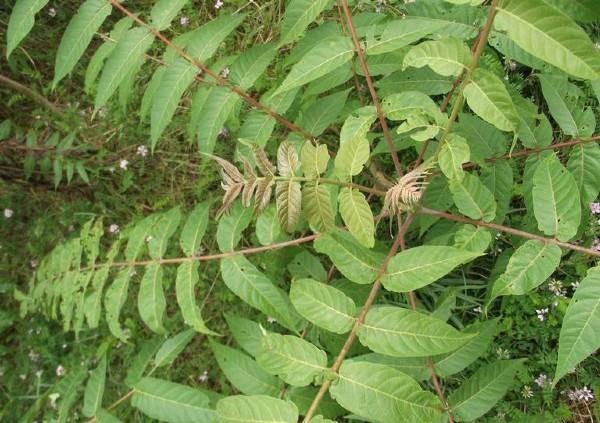
Tree-of-heaven (Ailanthus altissima) Photo: Richard Gardner, Bugwood.org
Current distribution & map of spotted lanternfly locations
Spotted lanternfly was first discovered in Berks County, Pennsylvania in 2014. A shipment of stone imported from Asia was contaminated with spotted lanternfly egg masses. Despite quarantine efforts, spotted lanternfly became established and continued to spread throughout southeastern Pennsylvania. It is now moving into nearby states including Maryland, Virginia, Delaware, and New Jersey.
-
Cornell University maintains a map of spotted lanternfly locations and quarantine areas in the US Northeast.
-
Based on climate data, most of the eastern half of the United States as well as California, Washington, and Oregon have suitable conditions for spotted lanternflies to expand their range. Refer to Lanternflies on the Move by University of Maryland by Professor Emeritus Dr. Michael Raupp.
The life stages of spotted lanternfly
Spotted lanternfly nymphs (immature form) resemble large black aphids with white spots. There are three instars (phases) of these early-stage nymphs and they are usually found from April-July.
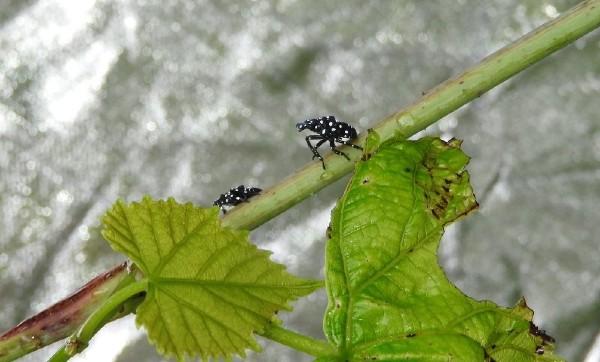
Spotted lanternfly nymphs (first instar). Photo: Richard Gardner, Bugwood.org
Later-stage nymphs (fourth instar) are red with white spots. These are typically found from July-September.

Spotted lanternfly (fourth instar nymph). Photo: Peter L. Coffey, University of Maryland Extension
Spotted lanternfly adults may be present from July through early November. The outer wings are grey with black spots and have a brick-like pattern at the wing tips. The hidden underwings have brightly contrasting large patches of red, black, and white. The legs and head are black. The abdomen has broad black bands, with yellow on the sides.
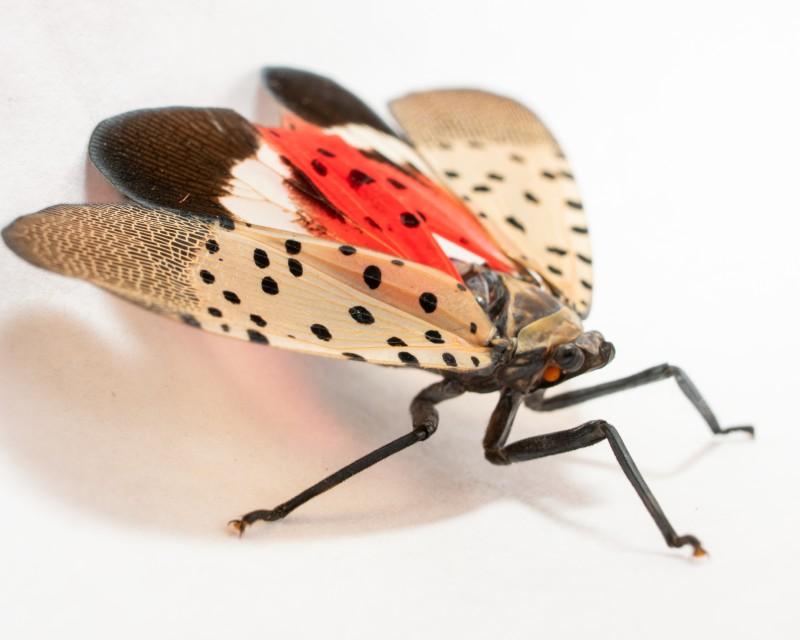
Spotted lanternfly adult. Photo: Peter L. Coffey, University of Maryland Extension
Spotted lanternfly eggs are laid in masses containing 30-50 individual eggs that will overwinter and hatch in the spring. Females will lay eggs on any flat vertical surface, including trees, stones, vehicles, grills, and outdoor furniture.
Fresh egg masses can be found from September-December. They are about one inch long and have a grey mud-like covering which cracks over time as it dries out. The covering eventually flakes off revealing 30-50 brown eggs which resemble seeds set in 4-7 rows. Depending on where the egg mass is laid, the egg mass may be well hidden.
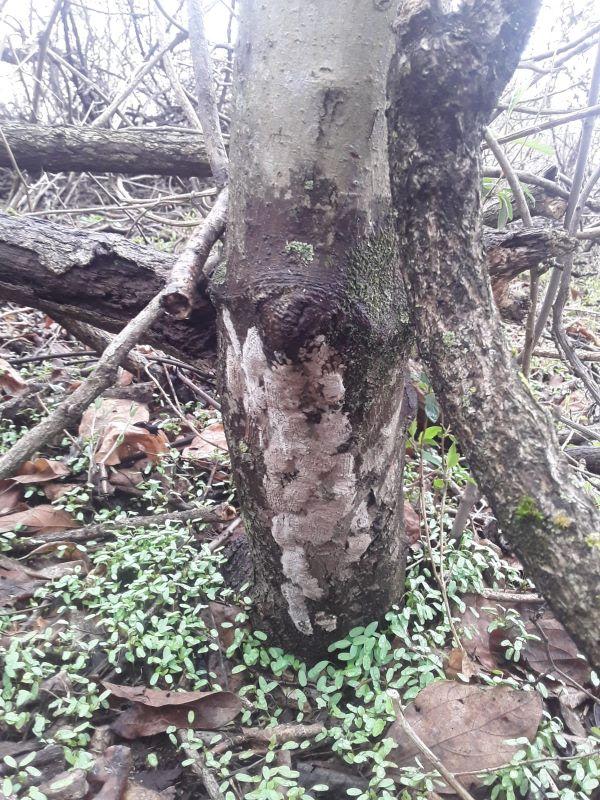
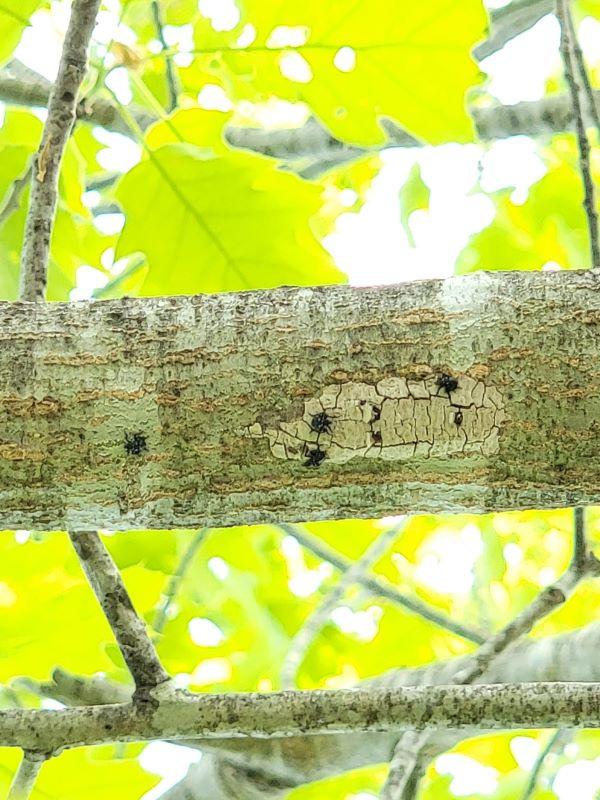
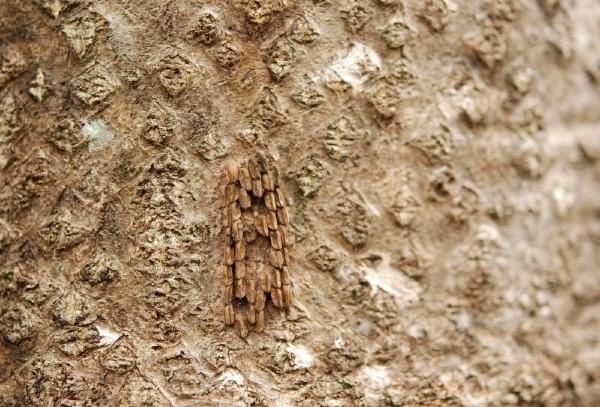
Spotted lanternfly eggs. Photo: Lawrence Barringer, Pennsylvania Department of Agriculture, Bugwood.org
Annual timeline

The young nymphs hatch out of eggs in April and develop through midsummer. They begin to grow into adults (in July). Adult females will lay eggs throughout the fall and will die by the start of winter. Egg will last through winter and hatch the following spring.
Stop the spread of spotted lanternfly
-
Prevent the spread of spotted lanternfly by inspecting your vehicle and any outdoor equipment (grills, mowers, camping supplies, firewood, etc.) when traveling in and out of the quarantine zones in Maryland, Pennsylvania, Ohio, Virginia, Delaware, New Jersey, and Connecticut. Refer to this (PDF) checklist to inspect for spotted lanternfly.
-
Businesses and institutions are required to have a permit if they move regulated articles from or within the quarantined area. Further details about the quarantine zone and permit requirements can be found on the Maryland Department of Agriculture website.
Manage spotted lanternfly around your home
What to do if you find spotted lanternflies in Maryland
-
While sightings of spotted lanternfly in Harford or Cecil counties no longer need to be reported, residents of all other Maryland counties are urged to report observations of SLF to the Maryland Department of Agriculture (MDA) as soon as possible. Submit your report to the MDA online. Questions or concerns about this pest also may be sent by email to DontBug.MD@maryland.gov or call (410) 841-5920.
-
Don't panic -- Spotted lanternflies are a nuisance pest in home landscapes. They do not bite or sting people or pets, they do not chew leaves, and they are not wood-boring pests of homes or other structures. They do not kill trees but can cause stress on them, so best management practices in the way of water management, soil health, and correct mulching will go far to help keep your plants healthy.
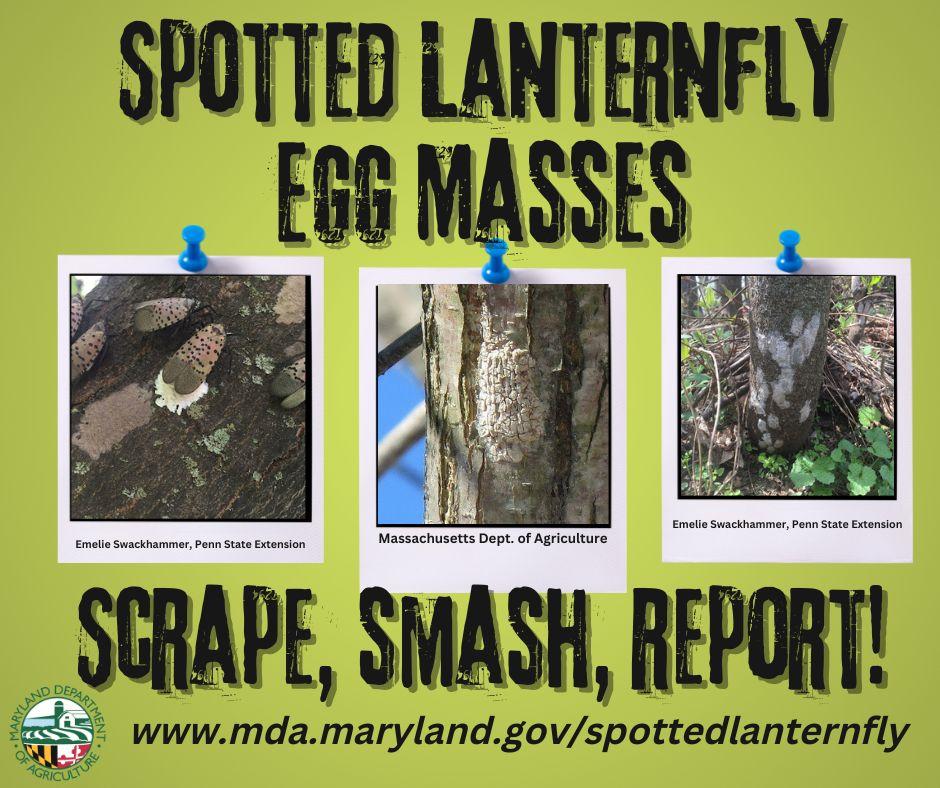
In residential yards and gardens, the recommended approach is to physically kill any spotted lanternflies that are safely reachable. Insecticide and other chemicals can harm non-target animals including pollinators and beneficial insectsand will not effectively reach and kill all of the spotted lanternflies that are present and on the move. SLF is not harming landscape or garden plants enough to justify the risks of using insecticidal sprays. Do not spray home remedies such as white vinegar or dish soap because these items can harm other animals and plants.
Management options
Cultural control
- Remove one of spotted lanternfly’s primary host plants, tree-of-heaven (Ailanthus altissima), from your property. Tree-of-heaven looks very similar to native sumac and black walnut, so correct identification of the plant is important. Watch this short video on tree-of-heaven and native look-alikes. Contact us if you need help with plant identification or information about control methods.
- Place exclusive netting with fine mesh over vulnerable plants like grape vines, tightly securing the sides and bottom of the netting. Spotted lanternfly may feed on any plant stems in direct contact with the netting. It is important to note netting could increase disease pressure under certain environmental conditions.
Mechanical (non-chemical) control
- Destroy spotted lanternfly adults and nymphs by crushing them with gloved hands, stomping on them by shoed feet, smashing them with fly swatters or rackets, or placing them in a container of soapy water or rubbing alcohol (isopropyl alcohol).
- Scrape egg masses off of woody plant bark and hard surfaces such as lawn furniture, decks, and concrete surfaces using a plastic card or tool such as a putty knife. The eggs must then be crushed in order to kill them. Eggs can be crushed with gloved hands or dropped into a container of rubbing alcohol or hand sanitizer. Watch a video about how to scrape and destroy spotted lanternfly eggs. Be sure you confirm the identity of the egg mass before destroying it. There are many beneficial insects that lay egg masses on bark and other hard surfaces.
- Purchase a trap or build a circle trap using instructions from Penn State Extension. Watch a video demonstration of how to install the trap.
- Adhesive (sticky) traps can be placed on trees but should be used in combination with a screen cover to prevent by-catch of birds, squirrels, beneficial insects, and other animals.
- Use a shop vacuum to suck up SLF, then destroy and discard them.
Biological control
- Natural enemies include spiders, praying mantids, assassin bugs, predatory stink bugs, and birds. Support a healthy environment for natural predators by reducing pesticide use and growing a variety of flowering plants and plant types in your landscape. Plant diversity provides food and habitat for natural enemies.
- Research is underway on biological control options such as entomopathogenic (insect-killing) fungi. Beauveria bassiana is a fungus that will cause a disease in SLF. It is commercially available but it is not practical to use in home gardens effectively. Furthermore, it is not specific to SLF and can have negative effects on non-target insects.
- Research on the use of certain parasitic wasp species, like egg parasitoid Anastatus orientalis and nymphal parasitoid Dryinus sinicus, for biological control of SLF is underway.
Chemical control
- Spotted lanternflies are constantly on the move. Spot-spraying and whole-yard insecticide treatments will only put a small, temporary dent in the population while also potentially harming animals such as beneficial insects.Insecticidal soap and neem oil are effective only if they are applied directly to spotted lanternflies and the surfaces on which they are feeding and walking. Neem oil and insecticidal soap have a short period of residual activity and would need to be re-applied at intervals recommended on the product label.
- We do not recommend spraying pyrethroid insecticides because they are non-selective and can harm non-target insects like pollinators
- Do not apply insecticides on lawns to control spotted lanternflies. Spotted lanternflies do not live in lawns.
- You are required by law to apply pesticides according to the directions on the label. This increases your safety, the safety of the environment, and the effectiveness of the pesticide. Home remedies may be harmful to people, pets, and/or plants and should not be used as pesticides.
- Avoid using homemade remedies against spotted lanternflies. Homemade solutions are not tested and not science-based and could harm humans, pets, other animals, and plants.
Additional resources
-
Maryland Department of Agriculture Spotted Lanternfly Information
-
Spotted Lanternfly Lore: Penn State Experts Clear Up Falsehoods About Pest | Penn State University
-
Spotted Lanternfly Management Guide | Penn State University
-
Spotted Lanternfly Management Resources | Penn State University
-
Help Find the Spotted Lanternfly | Dr. Michael Raupp, University of Maryland
-
Lanternflies on the Move | Dr. Michael Raupp, University of Maryland
-
Remove Tree-of-Heaven | Penn State University
